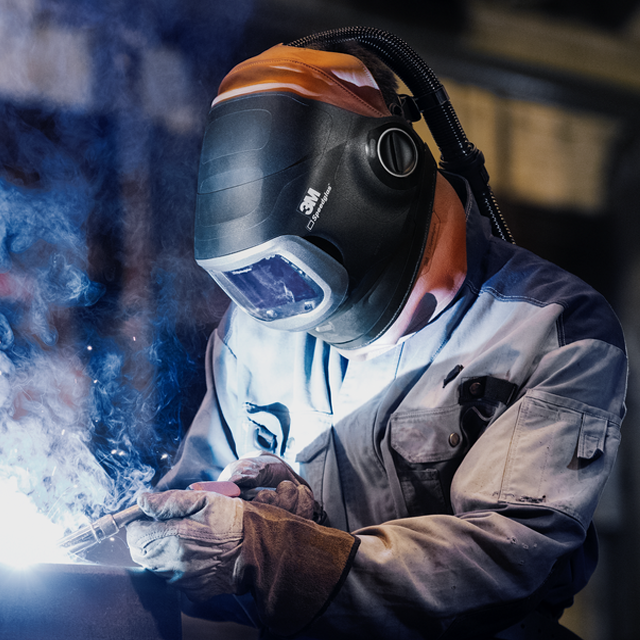

Auto darkening welding helmets provide effective protection against burns, extreme heat and radiant energy. They also speed up your performance because they do not require constant adjustment for different welding processes. They automatically adjust to light intensity and you don’t have to remove them to have a clear view of your weld piece and work surroundings.
So, how do auto darkening welding helmets work to keep the wearer safe from flying objects and harmful ultraviolet and infrared radiation? To understand what makes them effective protective gear, you need to know the anatomy of such a helmet and the role that each of the components serve to darken the lens in response to the brightness of an arc. We have discussed the various parts of an auto darkening welding helmet and the mechanism they use to lighten or darken the lens. They include sensors that detect the amount of light emitted by an arc and then activate the appropriate filter shade.

Auto darkening welding lenses comprise of three key parts:
We will explain what each component does so you can understand how auto darkening welding helmets work.
Auto darkening welding helmets consist of three polarization filters found in the lens layers, with the first filter appearing after the UV/IR layer at a 90-degree angle to the other polarizers.
These filters are positioned in different directions and they lighten or darken according to how they move when you look at them. When all the filters are at the same angle of orientation, you can see through them. The filters darken the most and dim all the outside light when they are positioned at 90 degrees and arranged on top of each other.
Polarization filters are responsible for darkening the light to protect your eyes from arc brightness, and the degree of darkening depends on their movement. They work with liquid crystals cells and UV/IR filter to protect you when wearing welding helmets with auto darkening lens.

A large number of sensors provide more extensive coverage. That is why industrial grade welding helmets for fabrication work usually come with four sensors to prevent obstruction of the sensors when you are out of position. There are also helmets with up to 6 sensors.
Light sensors work with arc sensors. The former blocks extra light whereas the latter filter out extreme arc brightness. These sensors are positioned on auto darkening filter located on the side ridges of the helmet to detect the light intensity of a welding arc and darken the lens correspondingly.
When you power an auto darkening welding helmet, it operates at shade 3. As you weld, the filter darkens to shades ranging from 8 to 13 depending on the amount of light emitted by an arc. Arc sensors and light sensors detect when you strike an arc and then determines the proper shade number to use to protect your eyes from strain or injury by darkening the lens.
The UV/IR interference filter is responsible for eliminating radiant energy from infrared and ultraviolet rays. You will find it outside the lens where it always stays on even when you adjust or deactivate the lens. The UV/IR filter features a thin layer of substrate glass that consists of multiple metallic layers.
There are 6 metallic layers made of aluminum oxide and 5 metallic layers made of silver. These metallic layers allow the lens to block at least 99% of infrared radiation within the lens shade range to protect your eyes and other components such as liquid crystal cells from heat damage caused by high welding temperature.
The substrate glass layer absorbs UV radiation and UVB radiation which causes melanoma, sunburns and skin cancer. However, it is not as effective at filtering out UVA radiation which can be difficult to detect.
For UVA, you need the metallic layers. The metallic layers do not work on their own to protect you from harmful ultraviolet rays. They work with polarization filters to filter UVA radiation and to prevent heat from penetrating the rest of the lens. You could consider the metallic layers the first line of defense that protects the other layers so they can work to provide optimal safety for you when welding.
The UV/IR filter absorb light that gives the lens of an auto darkening welding helmet a reflective, purple color. The filter is one of the key features that make auto darkening welding helmets safe by effectively eliminating ultraviolet and infrared radiation, whether the lens is activated or not.
Another component that makes auto darkening welding helmets safe against infrared and ultraviolet rays is liquid crystal cells, also known as LC screen. They are similar to polarization filters in that their position influences the way they reflect light.
When the liquid crystal cells are in a flat position, they defer light by 90 degrees and you cannot see through them. The two liquid crystal cells are placed between the polarization filters.
110V welders require electricity and 110V power outlet that is commonly available compared to finding an outlet for a 220V welder which works better on remote sites. Similarly, auto darkening welding helmets are available with electrical functionality to charge the liquid crystal cells and activate them. Electricity can stimulate the LC to move and refract light at a different angle or for the filters to not bend any light.

Your helmet will require electricity to stimulate movement of the liquid crystal cells. That is why you should charge it.
Prior to striking an arc, the two polarizing filters are positioned in the same direction that is perpendicular to the filter that is adjacent to the UV/IR layer. This is the default position of the filters where they use shade 5 or 6 and will not automatically darken the lens. However, polarization filters still ensure that your eyes are always protected from intense brightness even before activating the helmet or if the liquid crystal cells fail to work. This quality is one of the built-in protective features that keep auto darkening welding helmets safe. Another integrated feature that protects your eyes from intense light is the liquid crystal cells refracting light at a 90-degree angle and darkening your view when the lens is not switched on.
When you strike an arc after powering on the helmet, the arc sensors and light sensors detect the emitted light and subsequently activate the polarization filters and the liquid cell crystal panel. The sensor turns off the LC and the electricity shifts the crystal cells to reflect more light and to darken the lens back to shade 5 or 6 in response to the light sensitivity. This process usually occurs within 0.1 milliseconds after you strike the arc.
When you activate the liquid crystal cells electronically, they bend light into your eyes and brighten the lens to approximately shade 3 before you strike an arc. When the light sensors deactivate the LC after you strike an arc, the polarization filters refract light away from eyes to darken the lens.
After you complete welding, arc sensors detect the absence of light and lighten the lens to revert to a clear view that allows you to inspect the weld piece safely.
The liquid crystal panel and polarizing filters will slightly darken the lens, even if it is switched off, when positioned at a specific angle. Auto darkening welding helmets are safe because you don’t have to adjust the lens manually as long as you have set your desired shade level according to the current intensity and welding process. The helmet will use the preselected shade to darken automatically and protect you from infrared and ultraviolet radiation.
The American Welding Society Trusted Source Eye and Face Protection for Welding and Cutting Operations U.S. government agencies estimate that there are about 2,000 eye injuries each day in American workplaces. Most injuries are caused by not wearing eye protection or wearing the wrong kind of eye protection needed for the job. Additionally, nearly 70 percent of eye injuries are caused by flying particles. app.aws.org (AWS) features a lens shade selector guide with the corresponding amperes for various welding processes.
Auto darkening welding helmet manufacturers also feature the shade requirement for their models. A good illustration is YESWELDER LYG-M800H which has a wide shade range of 5 to 13; shade number 5 – 9 for grinding and cutting using Plasma, and shade number 9 – 13 for arc welding. This helmet also complies with the safety and technical requirements of EN379 and ANSI Z87.1.
ANSI Z87.1 is the industry eye protection standard set by the American National Standards Institute (ANSI). It offers guidelines on how to choose, use, mark, and maintain eye protection to prevent injuries. ANSI Z87.1 also provides information on how to test auto darkening welding helmets to confirm that they are working properly.
Below we have answered two of the questions we are often asked, including tips on how to test auto darkening welding helmets.
Auto darkening welding helmets that comply with ANSI/ISEA Z87.1-2020 Trusted Source ANSI/ISEA Z87.1-2020: Current Standard for Safety Glasses The current, most recent edition of the safety glasses and eye and face protection devices standard is ANSI Z87.1-2020 (ANSI/ISEA Z87.1-2020) blog.ansi.org are tested before they are distributed in the market. However, you need to learn how you can confirm that your helmet is still working properly after you have been using it. We will offer a simple guide on how to test auto darkening welding helmets. The first method is by looking at the sun with your helmet on. The glare should make the lens darken automatically to protect your eyes. The second method entails striking a MIG welding torch while wearing the helmet. It should darken in reaction to the spark. The third approach you can use to test auto darkening welding helmets is by wearing the helmet and then pointing a TV remote control to it. Press a remote button and the helmet, if working well, should become dark because of the infrared signal.
Auto darkening welding helmets are safe with proper use. They feature multiple protective features that prevent radiant energy and flying objects from harming your eyes, face and neck. The most important thing is for you to learn the key components and what they do, test auto darkening welding helmets to ensure they are in working order, and use the helmet for the recommended welding process.
Auto darkening welding helmets with appropriate filter shades are safe to wear to limit injury and exposure to harmful radiant energy. We have reviewed the different components that work together to protect you by automatically adjusting the lens according to the level of arc brightness. Some passively provide protection even when the lens is not activated, and others like liquid crystal cells require electricity to be activated into action. A main selling point for helmets with auto darkening filters is that you don’t have to remove them to have a clear view. The lens automatically brightens once you have completed welding so you can have a clear view of your work environment. How do auto darkening welding helmets work? Now you know. We recommend choosing a helmet that adheres to industry standards such as ANSI Z87.1 to ensure the product is durable and provides peak safety and performance.





